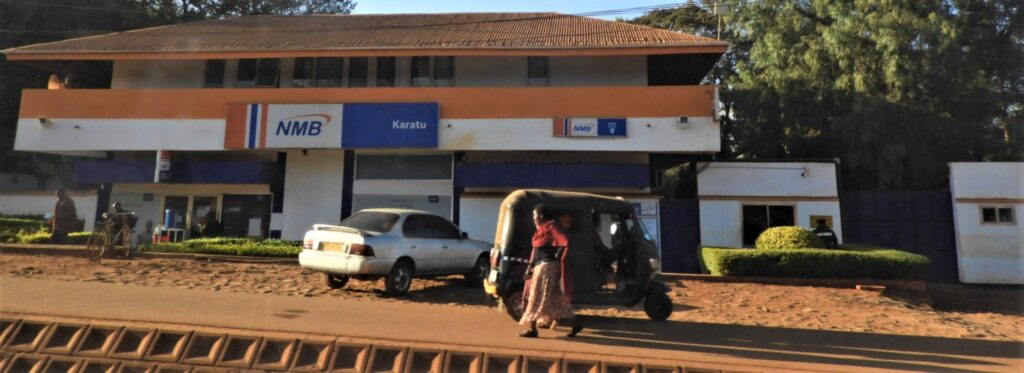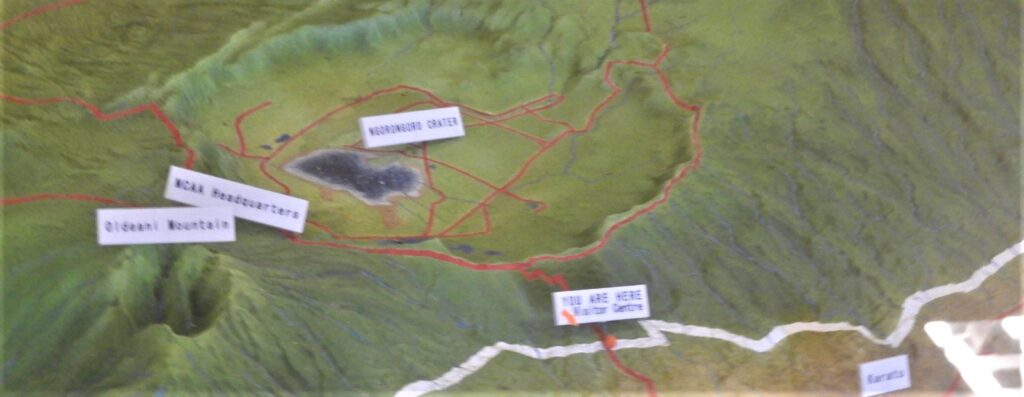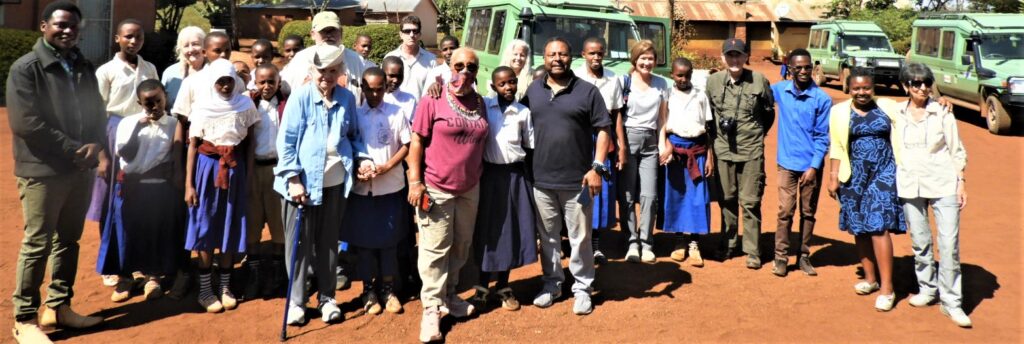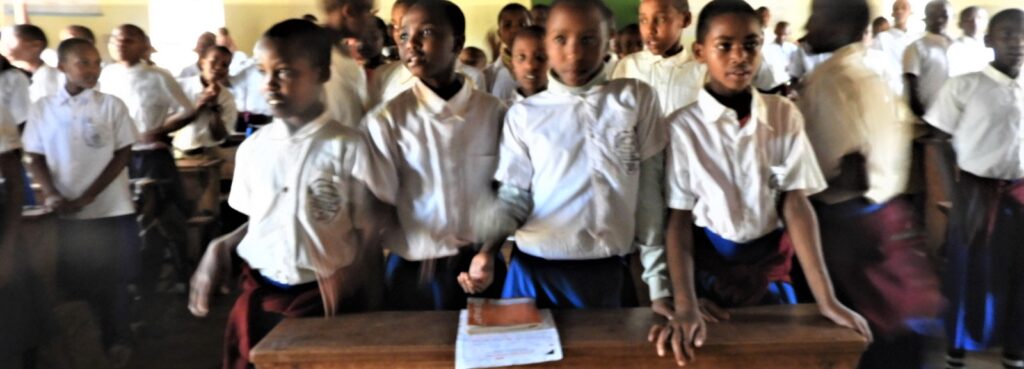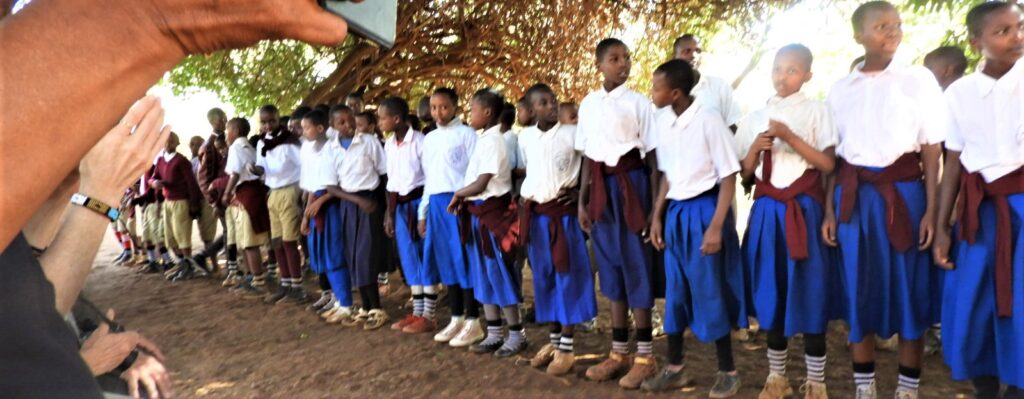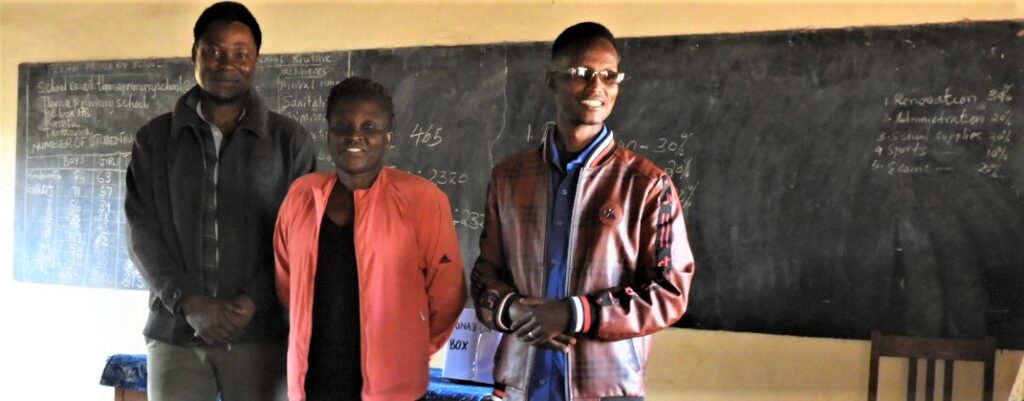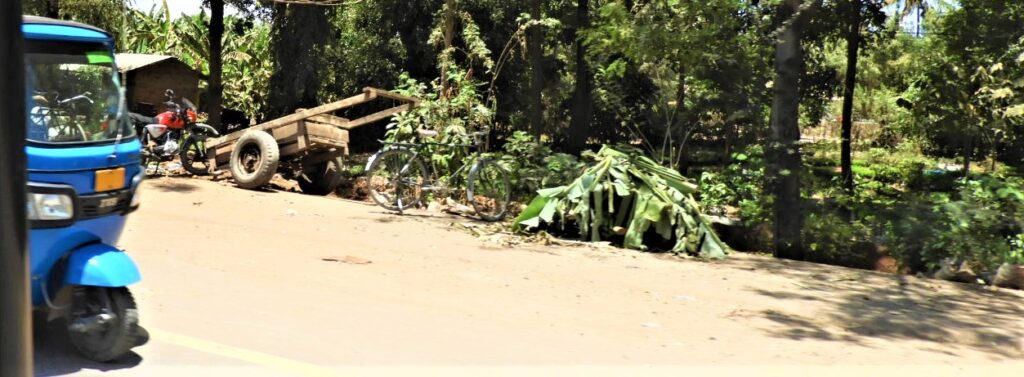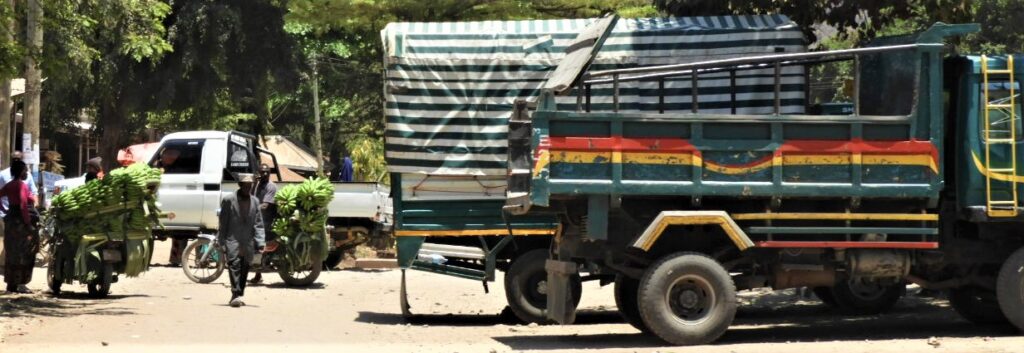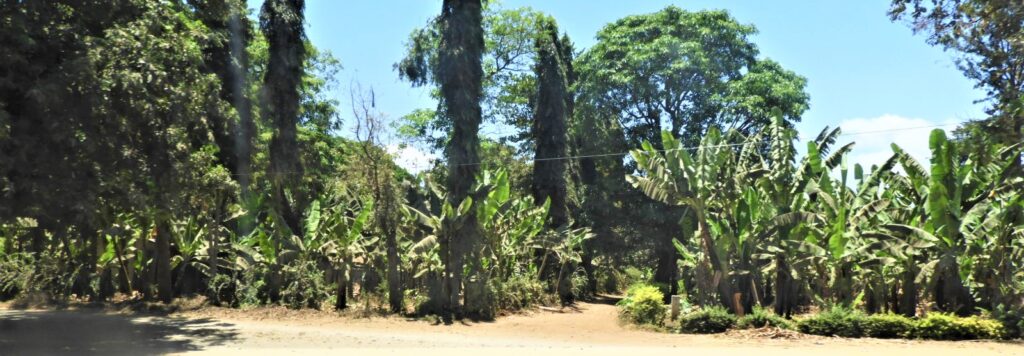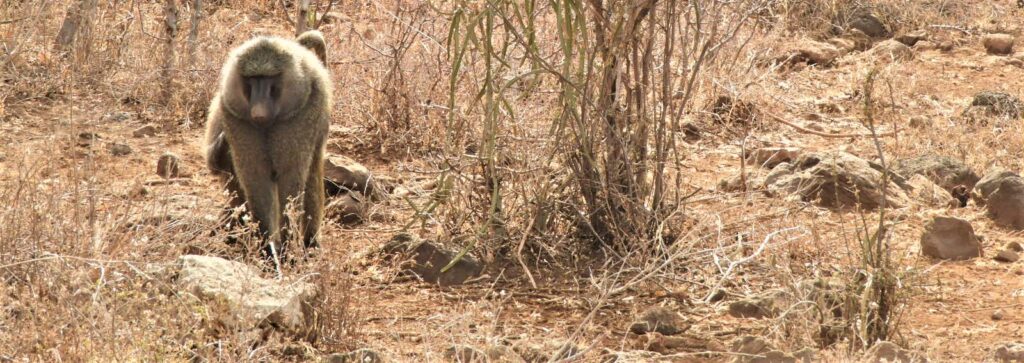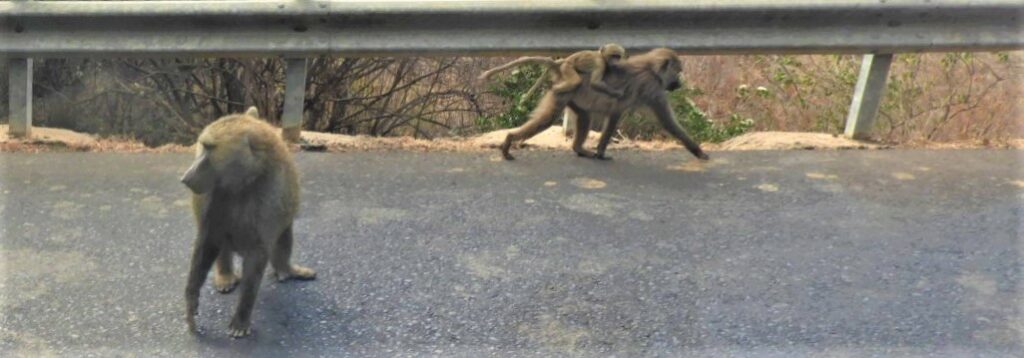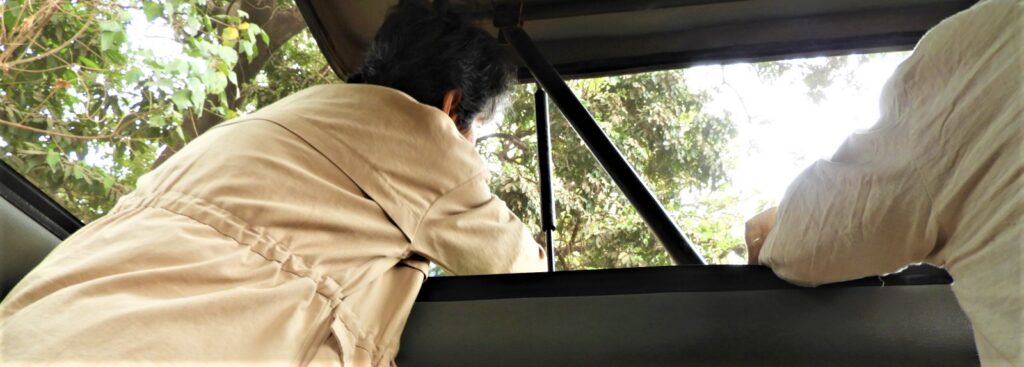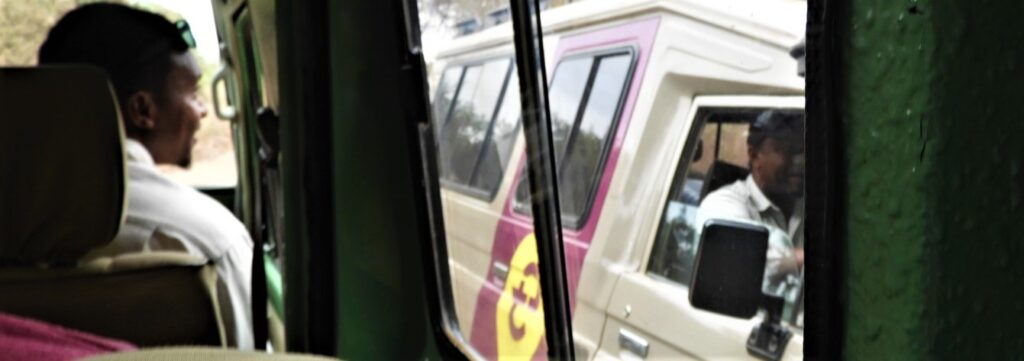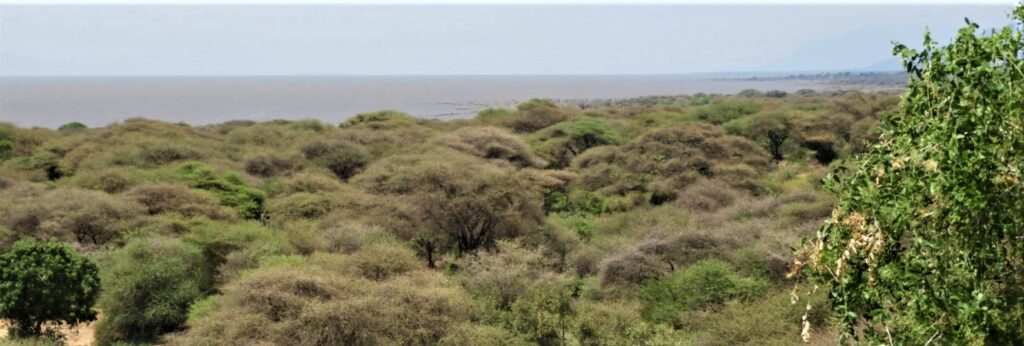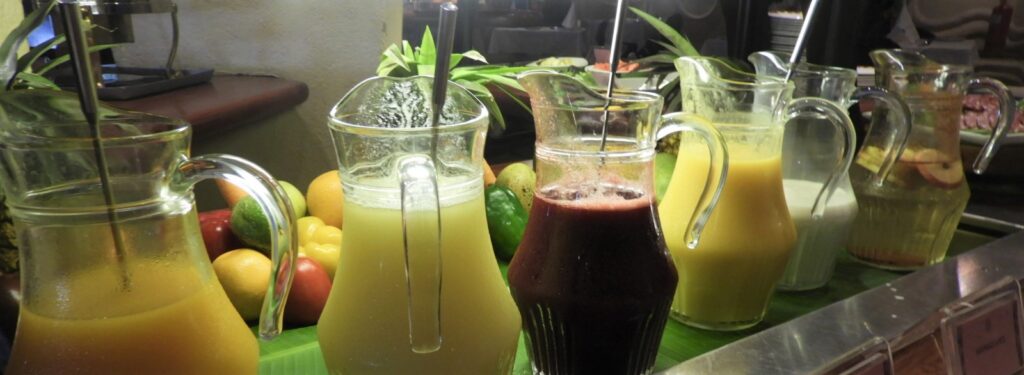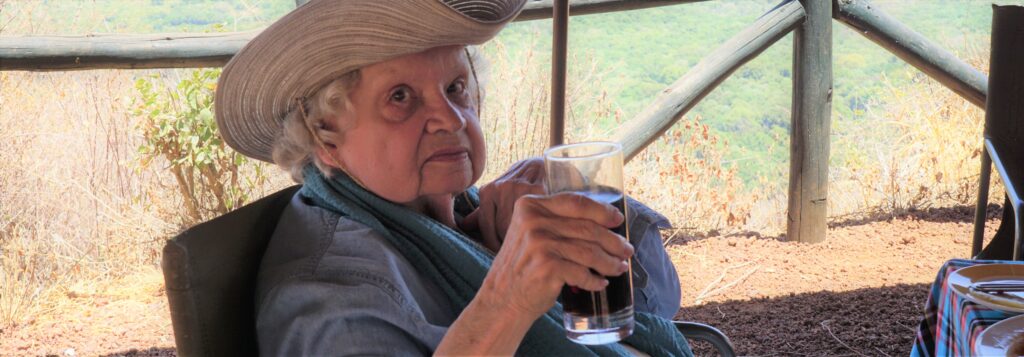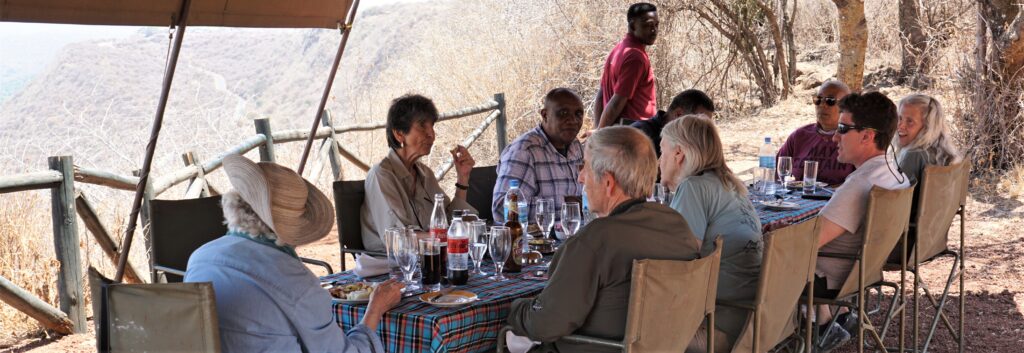Archive for September 20th, 2022
» posted on Tuesday, September 20th, 2022 by Linda Lou Burton
Double Cross Cross
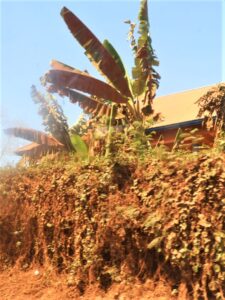 Linda Lou Burton posting from Ngorongoro Serena Safari Lodge, Ngorongoro Crater, Tanzania– It was 4:15 when we left Tloma school, all smiles and warm-glowy feelings. Such a good visit, such a happy buzz of conversation in the 4×4 as we headed down the road, stirring up a trail of red dust. I was calculating in my head: 25 miles to the rim of the Crater, we’d be checked into our Lodge and sitting on our balconies in time to see the sun set, oh yeah! (Sunset 6:30, keep in mind.) “But lo”, my scrappy angel said, “your 4×4 seems to be pulling into the drive of a small building just minutes from the school. And lo! Stopping.” Elephants and zebras and acacia trees captured on canvas, hanging on a line. Sailboats even!
Linda Lou Burton posting from Ngorongoro Serena Safari Lodge, Ngorongoro Crater, Tanzania– It was 4:15 when we left Tloma school, all smiles and warm-glowy feelings. Such a good visit, such a happy buzz of conversation in the 4×4 as we headed down the road, stirring up a trail of red dust. I was calculating in my head: 25 miles to the rim of the Crater, we’d be checked into our Lodge and sitting on our balconies in time to see the sun set, oh yeah! (Sunset 6:30, keep in mind.) “But lo”, my scrappy angel said, “your 4×4 seems to be pulling into the drive of a small building just minutes from the school. And lo! Stopping.” Elephants and zebras and acacia trees captured on canvas, hanging on a line. Sailboats even! 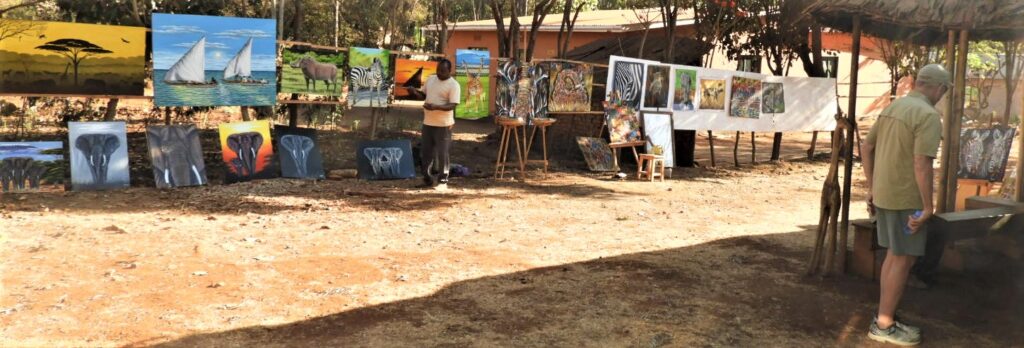 “We’re stopping here,” Ben said, “so you can browse around and find some nice paintings to buy. Some memories of Tanzania.” I looked at the scrappy angel sitting on my shoulder and vowed not to complain. Everyone else hustled out of the 4×4 and began browsing. Ben stayed with me. “Let’s talk about tomorrow,” he said. “We have decisions to make.” “Okay,” I responded, aiming for pleasant, “let’s talk.” Our schedule for tomorrow was ”All Day Game Drive in the Crater with Picnic Lunch.” Since the Crater was one of my main reasons for coming to Africa, I’d resolved since making my February trip deposit to go on THAT Game Drive if no other. Karen Blixen’s House and the Ngorongoro Crater, my two objectives.
“We’re stopping here,” Ben said, “so you can browse around and find some nice paintings to buy. Some memories of Tanzania.” I looked at the scrappy angel sitting on my shoulder and vowed not to complain. Everyone else hustled out of the 4×4 and began browsing. Ben stayed with me. “Let’s talk about tomorrow,” he said. “We have decisions to make.” “Okay,” I responded, aiming for pleasant, “let’s talk.” Our schedule for tomorrow was ”All Day Game Drive in the Crater with Picnic Lunch.” Since the Crater was one of my main reasons for coming to Africa, I’d resolved since making my February trip deposit to go on THAT Game Drive if no other. Karen Blixen’s House and the Ngorongoro Crater, my two objectives.
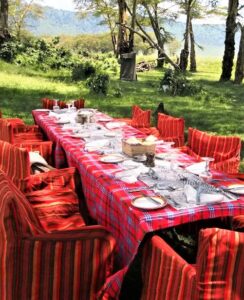 I told Ben of my enthusiasm for the day ahead, a full day in the Crater, with picnic lunch. “We could do that,” he said. “Or, we could leave at 4:30 and be in the Crater before daylight. We could have BREAKFAST in the Crater and be back at the Lodge for lunch.” My scrappy angel shook a finger at me; warned me to stay cool. “We’ve had a really busy day today,” I said to Ben, in my most diplomatic tone. “A 4:30 departure in the morning would be a tight timeline. People would be more rested if we stuck to the original plan and departed at 6:30.” Ben nodded pleasantly and agreed. “You’re right, 4:30 is pushing it. We’ll stick to the plan.” We chatted more; he told about his studies; a Masters Program in Tourism (that school in Arusha I mentioned earlier); he told about his areas of interest; his goals after that.
I told Ben of my enthusiasm for the day ahead, a full day in the Crater, with picnic lunch. “We could do that,” he said. “Or, we could leave at 4:30 and be in the Crater before daylight. We could have BREAKFAST in the Crater and be back at the Lodge for lunch.” My scrappy angel shook a finger at me; warned me to stay cool. “We’ve had a really busy day today,” I said to Ben, in my most diplomatic tone. “A 4:30 departure in the morning would be a tight timeline. People would be more rested if we stuck to the original plan and departed at 6:30.” Ben nodded pleasantly and agreed. “You’re right, 4:30 is pushing it. We’ll stick to the plan.” We chatted more; he told about his studies; a Masters Program in Tourism (that school in Arusha I mentioned earlier); he told about his areas of interest; his goals after that.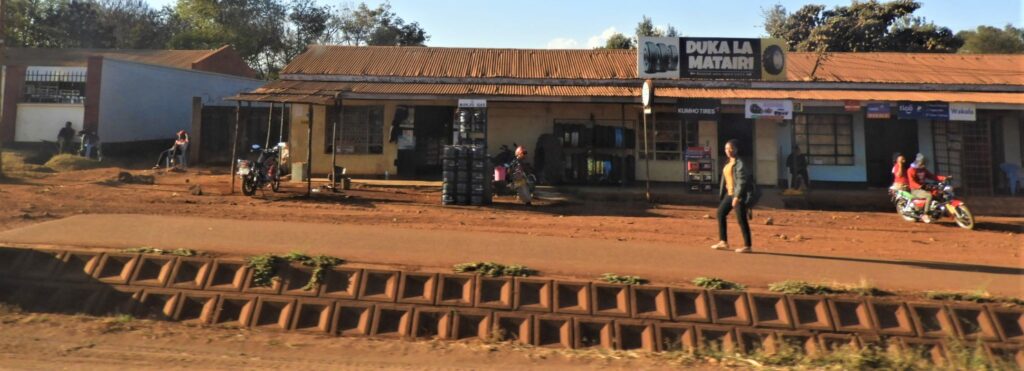
 The browsers returned (no purchases); our journey continued, dusty road to tarred road; at 5:30 we reached the Ngorongoro Conservation Area Visitor Center. “We’re going in,” Ben motioned to the other 4×4, “so I can explain the Crater to you.” Inside we gathered around the giant relief map; Ben talked about the geology of the Crater; the Conservation Area today; the Great Migration; the wildebeests. “The wildebeests live in Kenya part of the year,” he said, “but they belong to Tanzania.” (Wildebeests have citizenship?) We fidgeted. My scrappy angel nodded off.
The browsers returned (no purchases); our journey continued, dusty road to tarred road; at 5:30 we reached the Ngorongoro Conservation Area Visitor Center. “We’re going in,” Ben motioned to the other 4×4, “so I can explain the Crater to you.” Inside we gathered around the giant relief map; Ben talked about the geology of the Crater; the Conservation Area today; the Great Migration; the wildebeests. “The wildebeests live in Kenya part of the year,” he said, “but they belong to Tanzania.” (Wildebeests have citizenship?) We fidgeted. My scrappy angel nodded off.
“Oh, about tomorrow,” Ben said, concluding his wildebeest claim, “if we leave the hotel at 4:30 in the morning we’ll be down in the Crater before daylight, in position to see the animals as they become active. We can have the hotel pack a box breakfast, and be back at the Lodge in time for lunch. You’ll have a free afternoon. Sound OK?” Like lemmings led to the sea, the gang nodded, “Yeah, sounds great.” I stood up. “Wait! The original plan was LUNCH in the Crater, leaving at 6:30 in the morning, not 4:30. And that’s what you agreed we’d do.”
All eyes back to Ben. “Who wants to see the most animals?” he questioned. Eight hands rose. “Who wants to sleep in and see fewer animals?” he asked then, looking at me. Ah, well, my scrappy angel was dialing up KARMA at that very moment.
Next Post: Notes From The Balcony of Ngorongoro Serena Safari Lodge https://www.serenahotels.com/ngorongoro
» posted on Tuesday, September 20th, 2022 by Linda Lou Burton
Smiles At Tloma
Linda Lou Burton posting from Tloma Primary School, Karatu, Tanzania– Smiles. That’s the only word needed to describe our afternoon at Tloma Primary School, where our group of nine, plus two people from another Globus tour, visited this afternoon. Immanuel was the young fellow who ran out and took my hand, escorting me into the building with a sweet smile, walking as slowly alongside me as I needed. Inside, after a round of singing and story-telling from the children, led by a smiling teacher weaving her way around the room (if ever I’d had a teacher like that I’d know how to dance today!), we were invited to talk to the 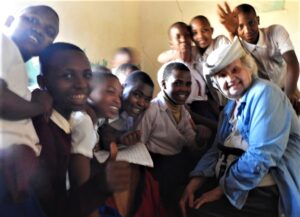 students about our part of the world, and to answer any questions they might have. Then, best of all, we got to sit with the students. My group of smiling boys called me Beebe (Grandma) and showed me their workbooks, pointing to the Swahili words for different family members: Mama and Baba for parents, on down the
students about our part of the world, and to answer any questions they might have. Then, best of all, we got to sit with the students. My group of smiling boys called me Beebe (Grandma) and showed me their workbooks, pointing to the Swahili words for different family members: Mama and Baba for parents, on down the 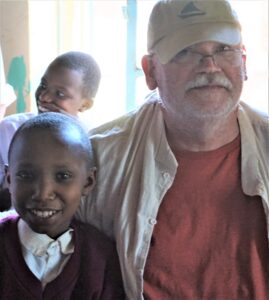 list. The singing show continued outside; the smiling did too; smiles exchanged, back and forth and around again. The adults had a sit down visit with three of the teachers after that, the blackboard behind filled with the facts of life: 815 students, 14 teachers. We were seated in the wooden desks they use; names of donors inscribed on each. Yes, the school needs help. Nothing there to smile about, except the fact that Tloma Giving is in place as a gateway for people to do just that. I’m choosing to send money to Tloma to be used for school supplies, thinking of those boys, and their notebooks, and their smiles. Photos of our visit below; see what I mean?
list. The singing show continued outside; the smiling did too; smiles exchanged, back and forth and around again. The adults had a sit down visit with three of the teachers after that, the blackboard behind filled with the facts of life: 815 students, 14 teachers. We were seated in the wooden desks they use; names of donors inscribed on each. Yes, the school needs help. Nothing there to smile about, except the fact that Tloma Giving is in place as a gateway for people to do just that. I’m choosing to send money to Tloma to be used for school supplies, thinking of those boys, and their notebooks, and their smiles. Photos of our visit below; see what I mean?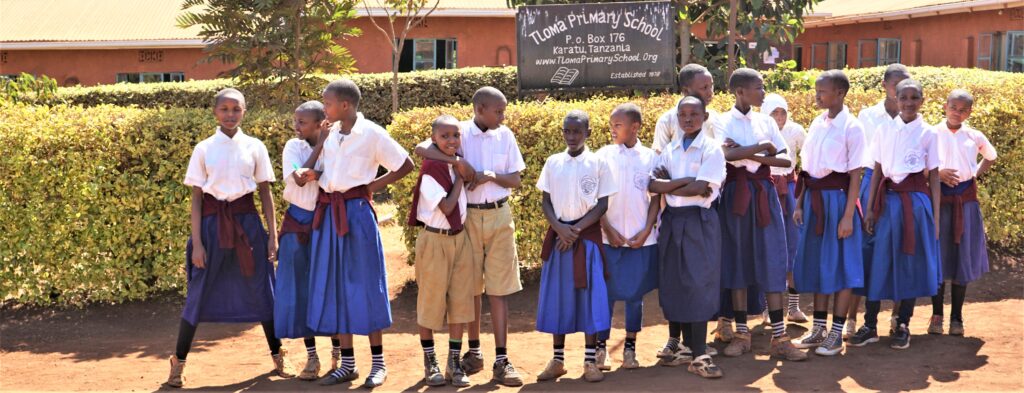
Tloma Primary School https://tlomaprimaryschool.org/about/
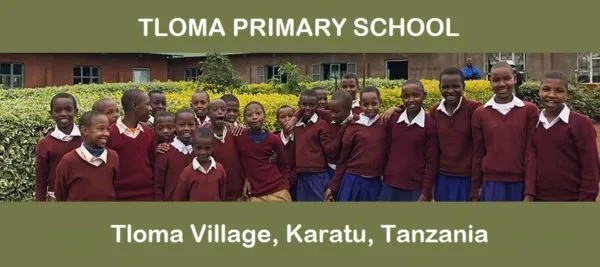
 Tloma Primary School is located in Tloma Village, a small community on the outskirts of Karatu, Arusha, Tanzania, situated low on the outer slope of the Ngorongoro Crater. Tloma means ‘hill’ in the Iraqw language, the native language of many people in the Village. The school was established in 1978 and has grown from a few students to the present enrollment of 815 children in grades Kindergarten through 7. The school currently has 14 teachers. The smallest class size is 67 students; the largest, Kindergarten, is 144 students. Children are introduced to the national language, Swahili, in Kindergarten and subjects through Class 7 are taught in Swahili. The English class begins in Class 4; once students graduate from Tloma Primary School to attend secondary school, all classes are taught in English.
Tloma Primary School is located in Tloma Village, a small community on the outskirts of Karatu, Arusha, Tanzania, situated low on the outer slope of the Ngorongoro Crater. Tloma means ‘hill’ in the Iraqw language, the native language of many people in the Village. The school was established in 1978 and has grown from a few students to the present enrollment of 815 children in grades Kindergarten through 7. The school currently has 14 teachers. The smallest class size is 67 students; the largest, Kindergarten, is 144 students. Children are introduced to the national language, Swahili, in Kindergarten and subjects through Class 7 are taught in Swahili. The English class begins in Class 4; once students graduate from Tloma Primary School to attend secondary school, all classes are taught in English.
The School Motto: Elimu ni ufunguo wa maisha (Education is the key of life).
Students begin each day by lining up outside on the playground and singing the patriotic song “Tanzania Nakupenda Kwa Moyo Wote” (Tanzania I Love You With All My Heart).
Watch the students sing – video https://tlomagiving.org/?page_id=446
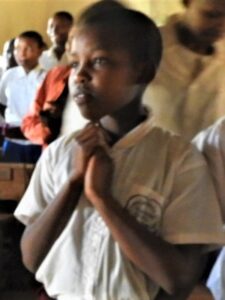 Tloma Giving is a U.S. non-profit educational and charitable corporation under Section 501(c)(3) of the Internal Revenue Service Code. The purpose of Tloma Giving is to provide support to foster the health, education, social, and economic development of the residents and families of the low-income and underserved Tloma region of the Karatu District, Arusha, Tanzania. We provide funding and support for facilities, training, supplies, and personnel, designed to improve educational opportunities for the children of the Tloma region. For students we provide scholarships, help purchase school uniforms and supplies, and help fund school lunches for students. For the school we help the school purchase teaching supplies and assist in capital improvements.
Tloma Giving is a U.S. non-profit educational and charitable corporation under Section 501(c)(3) of the Internal Revenue Service Code. The purpose of Tloma Giving is to provide support to foster the health, education, social, and economic development of the residents and families of the low-income and underserved Tloma region of the Karatu District, Arusha, Tanzania. We provide funding and support for facilities, training, supplies, and personnel, designed to improve educational opportunities for the children of the Tloma region. For students we provide scholarships, help purchase school uniforms and supplies, and help fund school lunches for students. For the school we help the school purchase teaching supplies and assist in capital improvements.
» posted on Tuesday, September 20th, 2022 by Linda Lou Burton
Quickies: The Town
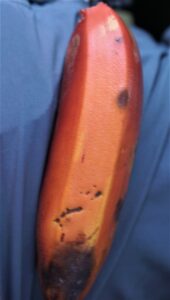 Linda Lou Burton posting from Mto Wa Mbu Village, Tanzania– The Quest For a Red Banana. Willy wanted to gas up the 4×4 and clean the inside a bit more from our morning explosion. Venita needed a bank. I wanted to see more of the banana trees we’d hurried past the night before. And Judy wanted to buy a red banana. Ben mentioned red bananas as something very “Tanzanian,” and Judy immediately said “Wow! Red bananas? Wow! How do they taste? Wow! RED bananas! Let’s go get some!” That’s why Willy turned right out of the Park and drove into Mto Wa Mbu, a touristy town in a handy dandy place for tourists halfway between Mt Kili-Arusha and the Ngorongoro Crater-Serengeti. Like us. The village is a crossroads for locals too; an agricultural hub famous for its crops of rice and bananas – yes, the distinctive RED bananas grow here. Red onions grow here too, as do tomatoes, coconuts, garlic, avocado, beans and more; trucks roll through town hauling the colorful crops. Add to this mix an incredible cultural diversity – 120 tribes live in the area; and the animal migration route — Mto Wa Mbu is in two wildlife corridors; and you can see this little town deserves a Wow!
Linda Lou Burton posting from Mto Wa Mbu Village, Tanzania– The Quest For a Red Banana. Willy wanted to gas up the 4×4 and clean the inside a bit more from our morning explosion. Venita needed a bank. I wanted to see more of the banana trees we’d hurried past the night before. And Judy wanted to buy a red banana. Ben mentioned red bananas as something very “Tanzanian,” and Judy immediately said “Wow! Red bananas? Wow! How do they taste? Wow! RED bananas! Let’s go get some!” That’s why Willy turned right out of the Park and drove into Mto Wa Mbu, a touristy town in a handy dandy place for tourists halfway between Mt Kili-Arusha and the Ngorongoro Crater-Serengeti. Like us. The village is a crossroads for locals too; an agricultural hub famous for its crops of rice and bananas – yes, the distinctive RED bananas grow here. Red onions grow here too, as do tomatoes, coconuts, garlic, avocado, beans and more; trucks roll through town hauling the colorful crops. Add to this mix an incredible cultural diversity – 120 tribes live in the area; and the animal migration route — Mto Wa Mbu is in two wildlife corridors; and you can see this little town deserves a Wow!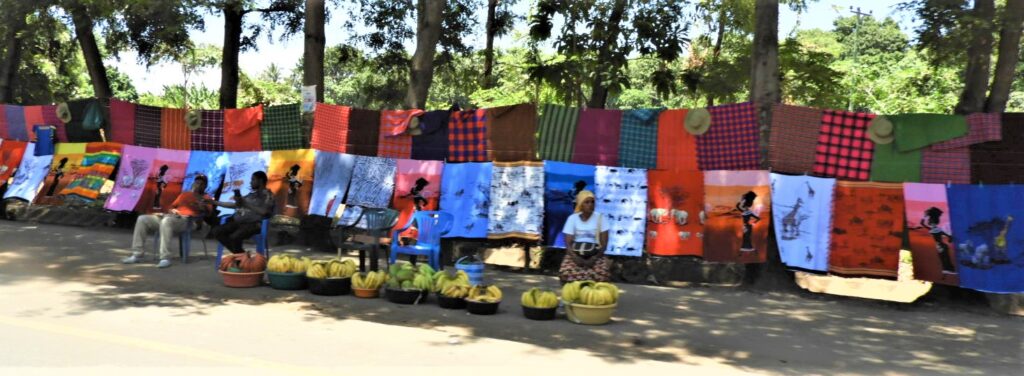
A shame we only had 30 minutes to spend here. Time enough to see the colorful shukas hanging on a line outside the Park, the colorful tuk-tuks ready for a ride, the colorful produce by the basketsful, and the bustle of noisy commerce. Willy took care of the 4×4. Venita took care of her business at the bank. And Judy got her red banana. I saw the banana trees again, another quick wave from the highway, no tuk-tuk ride through the rows. But I did learn this (which I’d wondered about) – Mto Wa Mbu means “river of mosquitoes” in Swahili.
A few photos of our Quickie Visit to the town.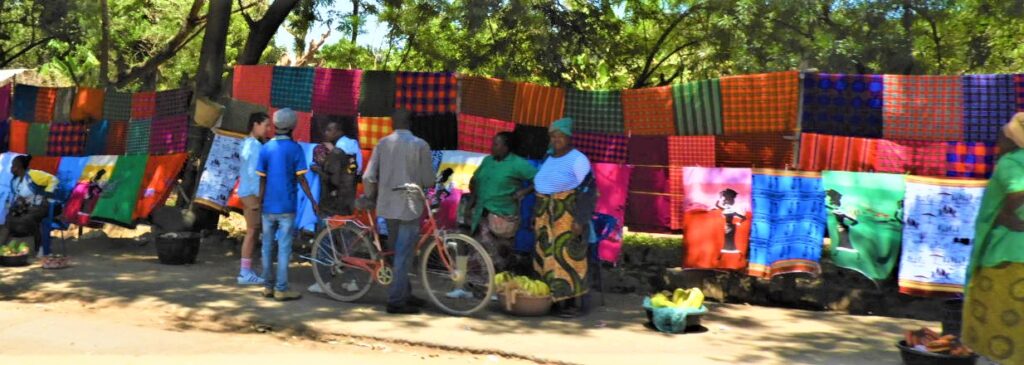
Mto Wa Mbu Village Information
 Mto wa Mbu has a population of 12,000+; 40,000+ in the area. Settled by the Mbugwe, Iraqw, Gorowa, Irangi, Totoga, Chagga and Maasai, the area is the most linguistically diverse and complex in Africa. It is the only place in the continent where the four major African language families – Bantu, Khoisan, Cushitic, and Nilotic – occur together.
Mto wa Mbu has a population of 12,000+; 40,000+ in the area. Settled by the Mbugwe, Iraqw, Gorowa, Irangi, Totoga, Chagga and Maasai, the area is the most linguistically diverse and complex in Africa. It is the only place in the continent where the four major African language families – Bantu, Khoisan, Cushitic, and Nilotic – occur together.
The main water sources in the area are the Mahamoud, Kirurumu and Magadini Rivers; the banana trees are watered by irrigation systems from these rivers. Green bananas grow in nine months; red bananas require one year, and each tree only produces one bunch.
Animals commonly seen in the area on the migration routes include elephant, hippo, giraffe, wildebeest, zebra, gazelle, monkey, and baboon.
 Mto Wa Mbu Village has an active cultural program showing visitors the traditional way of life of the villagers through various activities and a range of community projects. You can visit top spots in the area, taste Tanzanian foods, and experience authentic cultural interaction. A fee is charged for each activity which is then used to support income-generating projects such as the production of energy-efficient stoves and the development of irrigation systems. Students will find the village and its people to be a great resource for information on Tanzania. Everyday topics can be explored as well as more complex subjects like politics, history and culture, wildlife and legends. There are a number of excellent walking, hiking and biking tours offered in the village ranging in length from a few hours to a full day (bikes can be hired in the village).
Mto Wa Mbu Village has an active cultural program showing visitors the traditional way of life of the villagers through various activities and a range of community projects. You can visit top spots in the area, taste Tanzanian foods, and experience authentic cultural interaction. A fee is charged for each activity which is then used to support income-generating projects such as the production of energy-efficient stoves and the development of irrigation systems. Students will find the village and its people to be a great resource for information on Tanzania. Everyday topics can be explored as well as more complex subjects like politics, history and culture, wildlife and legends. There are a number of excellent walking, hiking and biking tours offered in the village ranging in length from a few hours to a full day (bikes can be hired in the village).
- Village Tour – try banana beer, visit a traditional home, learn about Makonde carving
- Village Lunch – enjoy a home-cooked meal the traditional way
- Farm Visit – discover what the villagers grow and how they do it
- Maasai Tour – visit a traditional boma (enclosure), interact with tribal members in various activities
- Maasai Market -browse the weekly market on Thursday afternoons or the monthly market on the 22nd
- Balaa Hill – climb up the Rift Valley Wall for magnificent views and good birding
- Miwaleni Lake and Waterfall – see ancient baobab trees and swim in the pool below the falls
- Lake Manyara – bike through a wildlife corridor to the shores of the lake
Mto Wa Mbu Village https://www.safari.co.za/Tanzania_Travel_Guide-travel/mto-wa-mbu-village.html
» posted on Tuesday, September 20th, 2022 by Linda Lou Burton
Quickies: The Park
Linda Lou Burton posting from Lake Manyara National Park, Tanzania– Tree-climbing lions! That was enough to get up early for. And no long drive to get there; heck, the Park was 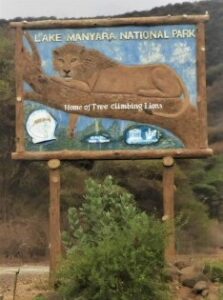 just at the bottom of the hill. Ten minutes to THERE. Out the gate of the Lodge, down the hill a thousand feet; into the gate of the Park. Easy Peasy Game Drive, no sloshing through mudholes and bumping across rocky plains. Just go. Ben the guide, Willy the driver, Otis and Venita row 2, Rick and me row 3, Judy row 4, along with the cooler and water supply. We were packed and ready. First animal spotting going down the hill: baboons, owning the road, babies, early morning action. The Park Gate, fees paid; top up on the 4×4, Judy and Rick standing up, looking out, scanning the trees for lions. Willy chatting with another driver, morning spotting so far? Baboons everywhere, bushes, vines; underbrush thick. Trees, dying trees, dead trees, four buffalo in the mud. Trees, sit and watch
just at the bottom of the hill. Ten minutes to THERE. Out the gate of the Lodge, down the hill a thousand feet; into the gate of the Park. Easy Peasy Game Drive, no sloshing through mudholes and bumping across rocky plains. Just go. Ben the guide, Willy the driver, Otis and Venita row 2, Rick and me row 3, Judy row 4, along with the cooler and water supply. We were packed and ready. First animal spotting going down the hill: baboons, owning the road, babies, early morning action. The Park Gate, fees paid; top up on the 4×4, Judy and Rick standing up, looking out, scanning the trees for lions. Willy chatting with another driver, morning spotting so far? Baboons everywhere, bushes, vines; underbrush thick. Trees, dying trees, dead trees, four buffalo in the mud. Trees, sit and watch 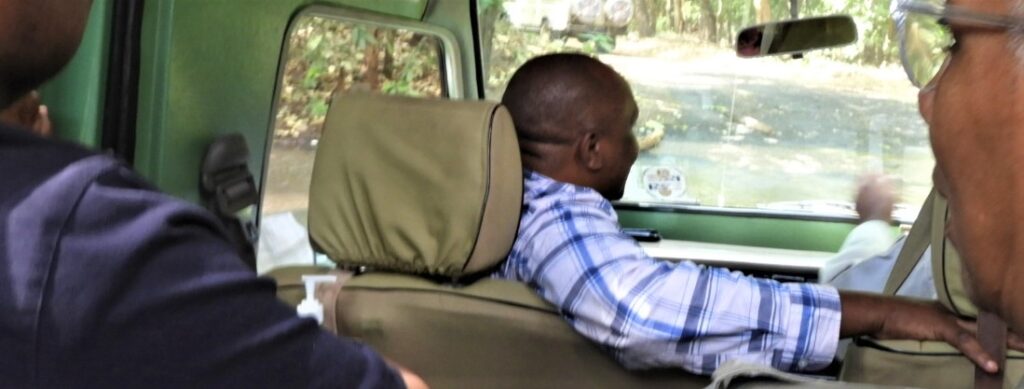 and wait for lions. Ben talking, telling stories, childhood lessons his mother taught. Time dragging. We were bored. Nuts! I remembered the nuts! The chocolate covered already gone; ha, wasabi peanuts left. I passed the bag around. No thanks, no thanks, nobody wanted wasabi heat. Except Willy. And then the scream! “Hot! Hot! Water! Water!” Excitement, finally, and then a brag. As Willy sucked the water down, Rick (Watch this! he said) took a wasabi nut, chewed slowly, swallowed it down. We nodded, impressed (only I was close enough to spot the tears); looked around for lions again. An explosion! In the front of the 4×4! Foam spewing, the windshield turning white, Willy yelling, Ben jumping what was going on??? Is the 4×4 on fire? Did the radiator burst? Should we bail? Willy opened his door, threw the spewing fire extinguisher on the ground. Ben moving fast, is Willy hurt? Is anybody hurt? “I’m okay,” Willy said. “The fire extinguisher blew up.” He began wiping down the inside of the 4×4, busy, cleaning up. “I’m okay,” he said again. “The fire extinguisher just blew up.” We could see, Willy was fine. Ben checked all around the 4×4, got back inside. “The fire extinguisher blew up.” Willy said again. “I don’t know why.” It was very quiet. And then, a burst of laughter, hoots and swoops of laughter, “Oh Willy, Willy, it was that wasabi nut!”
and wait for lions. Ben talking, telling stories, childhood lessons his mother taught. Time dragging. We were bored. Nuts! I remembered the nuts! The chocolate covered already gone; ha, wasabi peanuts left. I passed the bag around. No thanks, no thanks, nobody wanted wasabi heat. Except Willy. And then the scream! “Hot! Hot! Water! Water!” Excitement, finally, and then a brag. As Willy sucked the water down, Rick (Watch this! he said) took a wasabi nut, chewed slowly, swallowed it down. We nodded, impressed (only I was close enough to spot the tears); looked around for lions again. An explosion! In the front of the 4×4! Foam spewing, the windshield turning white, Willy yelling, Ben jumping what was going on??? Is the 4×4 on fire? Did the radiator burst? Should we bail? Willy opened his door, threw the spewing fire extinguisher on the ground. Ben moving fast, is Willy hurt? Is anybody hurt? “I’m okay,” Willy said. “The fire extinguisher blew up.” He began wiping down the inside of the 4×4, busy, cleaning up. “I’m okay,” he said again. “The fire extinguisher just blew up.” We could see, Willy was fine. Ben checked all around the 4×4, got back inside. “The fire extinguisher blew up.” Willy said again. “I don’t know why.” It was very quiet. And then, a burst of laughter, hoots and swoops of laughter, “Oh Willy, Willy, it was that wasabi nut!”
There’s nothing like a catastrophe to bond people together. We forgot about the lions, and the overall lack of animal spotting. We did see ONE fierce animal for the day. Ben noticed two tiny gazelles shivering nervously in the brush; his eyes looking past the vines, he whispered  “Willy, stop!” A python curled there, swollen, huge. “A gazelle inside,” Ben said; “two grieving gazelles back there.” We sat and watched for a bit, but a python full of gazelle doesn’t move a lot. Our animal count for three hours in the Park: 1 python; 3 gazelles, 1 hidden in the python; 4 buffalo in the mud, 15 baboons hiney-end up. Star of the morning: wasabi nuts. Fire!
“Willy, stop!” A python curled there, swollen, huge. “A gazelle inside,” Ben said; “two grieving gazelles back there.” We sat and watched for a bit, but a python full of gazelle doesn’t move a lot. Our animal count for three hours in the Park: 1 python; 3 gazelles, 1 hidden in the python; 4 buffalo in the mud, 15 baboons hiney-end up. Star of the morning: wasabi nuts. Fire!
A few photos of our Quickie Morning Park Visit and the road in.
Yes, we had our own story to tell!
Lake Manyara National Park https://www.lakemanyaranationalparks.com/
Lake Manyara National Park is a protected area between Lake Manyara and the Great Rift Valley, administered by the Tanzania National Parks Authority, and covering an area of 80,000 acres. It is part of the much larger Lake Manyara Biosphere Reserve, established in 1981 by UNESCO as part of its Man and the Biosphere Programme.
Lake Manyara is a shallow alkaline lake at an altitude of 3,150 ft, formed in a depression in the Rift Valley System. When full, the lake is a maximum of 10 ft deep and covers two-thirds of the park. The lake has no outflow, but is fed by underground springs and several permanent streams. In extreme dry periods the lake shrinks as the waters evaporate and at times has dried up completely. Beside the lake are extensive marshlands, saline flats (that expand as the surface area of the lake shrinks) and a grassy floodplain. Near the park gate  is a tall forest, sustained by groundwater, dominated by evergreen fig and mahogany trees. On the west side of the park, the rocky escarpment of the Rift Valley wall rises steeply to 6,000 ft. Large African baobab trees are scattered on the slopes and dense acacia woodland grows at the base of the Rift wall.
is a tall forest, sustained by groundwater, dominated by evergreen fig and mahogany trees. On the west side of the park, the rocky escarpment of the Rift Valley wall rises steeply to 6,000 ft. Large African baobab trees are scattered on the slopes and dense acacia woodland grows at the base of the Rift wall.
More than 390 species of birds have been documented in the Park, although in the dry season flamingos and other water birds are found in small numbers. Herbivores in the Park include zebra, bushbuck, waterbuck, Grant’s gazelle, impala, Thomson’s gazelle, Cape buffalo, giraffe, hippopotamus, baboon, warthog, and elephant. Predators in the Park include lion, leopard, African wild cat, spotted hyena, jackal, bat-eared fox, serval, honey badger, and mongoose. Cheetah and African golden cat are sighted occasionally.
» posted on Tuesday, September 20th, 2022 by Linda Lou Burton
Quickies: The Lodge
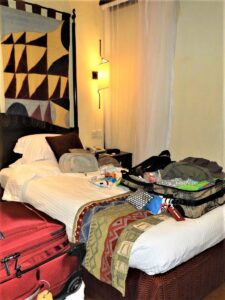 Linda Lou Burton posting from Lake Manyara Serena Safari Lodge, Lake Manyara National Park, Tanzania– 6:15 PM luggage in; 6:15 AM luggage out. Minus out the sleeping time, and the shower time and the poolside time and the dinner time, there was no time left for a sit on our veranda, gazing out across the lake in the valley; breathing in the fresh morning air; listening to the birds. That’s assuming, of course, that the air was fresh and the birds were singing. I was stuffing (not packing) the few things back into my fancy-schmancy palm-tree-brown suitcase that I had bothered to take out; my toothbrush, my morning meds. Passport attached to body; green mosquito-repellent scarf around my neck; hat on head. Rick was stuffing his stuff in the other corner of the room; conversation nil. Both of us were tired, stunned might be a better word; too rushed, the reason why. We needed a break! Alas, Tuesday, September 20, 2022 was not the day we got one. Variety, however, spiced up our lives; surprises at every curve of the road. I guess that’s
Linda Lou Burton posting from Lake Manyara Serena Safari Lodge, Lake Manyara National Park, Tanzania– 6:15 PM luggage in; 6:15 AM luggage out. Minus out the sleeping time, and the shower time and the poolside time and the dinner time, there was no time left for a sit on our veranda, gazing out across the lake in the valley; breathing in the fresh morning air; listening to the birds. That’s assuming, of course, that the air was fresh and the birds were singing. I was stuffing (not packing) the few things back into my fancy-schmancy palm-tree-brown suitcase that I had bothered to take out; my toothbrush, my morning meds. Passport attached to body; green mosquito-repellent scarf around my neck; hat on head. Rick was stuffing his stuff in the other corner of the room; conversation nil. Both of us were tired, stunned might be a better word; too rushed, the reason why. We needed a break! Alas, Tuesday, September 20, 2022 was not the day we got one. Variety, however, spiced up our lives; surprises at every curve of the road. I guess that’s  what happens when your day is crammed so full you think you’re gonna die. But, you probably won’t. Die, that is. You’ll just have lots of stuff to think about when you get home.
what happens when your day is crammed so full you think you’re gonna die. But, you probably won’t. Die, that is. You’ll just have lots of stuff to think about when you get home.
The Lodge, first; Lake Manyara Serena Safari Lodge. Some of my photos, and some of theirs. Those round thatch-roofed rondavels were the most unique sleeping accommodations I’ve ever had, and I didn’t get one good picture in our short time there. The dining room, the pool, totally cool! We had three meals with Serena Lodge – dinner, breakfast, and a Bush Lunch, with table under tent cover at the edge of the escarpment, chef’s outdoor grilling station, and patrol guard.
Lake Manyara Serena Safari Lodge, https://www.serenahotels.com/lake-manyara
Tanzania’s towering Mto wa Mbu escarpment provides a remarkable backdrop for Lake Manyara Serena Safari Lodge; a peaceful location amidst the rich wildlife of Lake Manyara National Park. The lake is home to over 300 migratory birds; the Lodge’s architectural motif features swooping avian curves and vibrantly colored wall frescoes depicting bird migratory patterns. Spread along the edge of the cliff for incredible views, accommodations consist of circular, double-story, whitewashed “rondavels” (traditional circular buildings with conical thatched roofs), which include their own small veranda. 
 Flamingo Restaurant is designed to replicate a Maasai boma, with swirling primary colors on textured white walls and traditional beadwork, gourds and leatherwork, and includes a veranda with picturesque views. The scenic outdoor terrace and infinity pool offer awe-inspiring lake views; it’s also the venue for cultural dance and music performances, usually held in the evenings. A variety of activities are offered by the Lodge, from village visits and nature walks to biking, jogging, archery, painting, and language and cooking lessons.
Flamingo Restaurant is designed to replicate a Maasai boma, with swirling primary colors on textured white walls and traditional beadwork, gourds and leatherwork, and includes a veranda with picturesque views. The scenic outdoor terrace and infinity pool offer awe-inspiring lake views; it’s also the venue for cultural dance and music performances, usually held in the evenings. A variety of activities are offered by the Lodge, from village visits and nature walks to biking, jogging, archery, painting, and language and cooking lessons.

